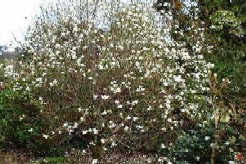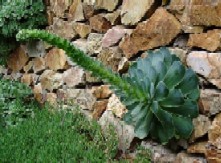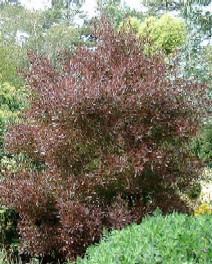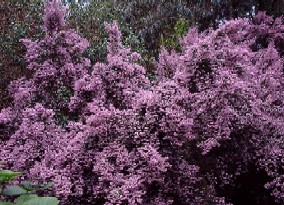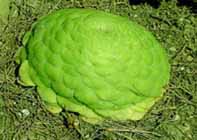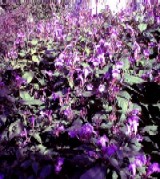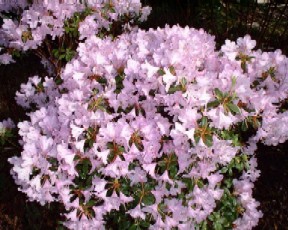Garden & Plants / Plants that grow well at Earlscliffe / Picture Gallery
Previous / Next: Juania Australis - A first ever - and it's a girl! / Furcraea 2009
Picture gallery
Click on any photo to open an enlargement
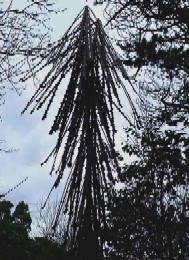 Pseudopanax
ferox (toothed lancewood) with remarkable stiff sword-like juvenile
leaves (photographed April 7, 2000). It is native to New Zealand. Once
the slow growing tree reaches maturity at 10-15 years, the leaf form
becomes shorter, wider and dark green in colour. It is only in adulthood
that the tree's shape changes from one central stem and downward growing
leaves to a more typical tree shape with branches spreading to build a
round head. Pseudopanax
ferox (toothed lancewood) with remarkable stiff sword-like juvenile
leaves (photographed April 7, 2000). It is native to New Zealand. Once
the slow growing tree reaches maturity at 10-15 years, the leaf form
becomes shorter, wider and dark green in colour. It is only in adulthood
that the tree's shape changes from one central stem and downward growing
leaves to a more typical tree shape with branches spreading to build a
round head. |
|
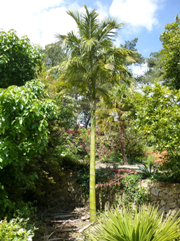 Of
many palms planted at Earlscliffe between 1990 and 1999, the most
successful has been
Juania australis. This plant has now become very rare due to
forest clearance on Juan Fernandez island. Plant donated by RHS
Rosemoor in September 1995 (photographed June 14, 2015 at 8 metres tall) Of
many palms planted at Earlscliffe between 1990 and 1999, the most
successful has been
Juania australis. This plant has now become very rare due to
forest clearance on Juan Fernandez island. Plant donated by RHS
Rosemoor in September 1995 (photographed June 14, 2015 at 8 metres tall) |
|
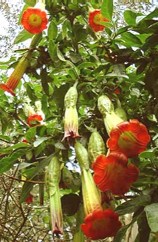 Brugmansia
sanguinea, or “Scarlet Angel’s Trumpet” can grow to 5 metres high
and can be in flower any month of the year depending on the temperature.
It doesn't like the cold and will die back in low temperatures. However,
so far it has always sprouted again the following spring. Brugmansia
sanguinea, or “Scarlet Angel’s Trumpet” can grow to 5 metres high
and can be in flower any month of the year depending on the temperature.
It doesn't like the cold and will die back in low temperatures. However,
so far it has always sprouted again the following spring.
|
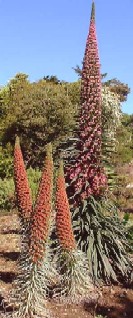 Echium
wildpretii (red flowers) with Echium wildpretii x
pininiana
(magenta flowers). Seed of both was saved from same parent plant in
August 1998 and sown in March 1999 Echium
wildpretii (red flowers) with Echium wildpretii x
pininiana
(magenta flowers). Seed of both was saved from same parent plant in
August 1998 and sown in March 1999 |
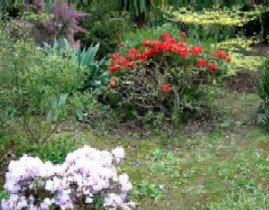 Left
hand side from top - Erica canaliculata, Beschorneria yuccoides,
Banksis spindulosa 'Collina' (Hairpin Banksia) and Rhododendron
'Phalarope' (R. davidsonianum x R. pemakoense). Centre
of picture - R.'Elizabeth' (R.forrestii x R.griersonianum).
Right hand side, top - Cornus controversa 'Variegata'. Left
hand side from top - Erica canaliculata, Beschorneria yuccoides,
Banksis spindulosa 'Collina' (Hairpin Banksia) and Rhododendron
'Phalarope' (R. davidsonianum x R. pemakoense). Centre
of picture - R.'Elizabeth' (R.forrestii x R.griersonianum).
Right hand side, top - Cornus controversa 'Variegata'. |
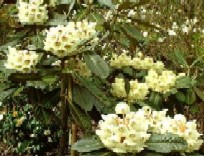 Rhododendron
macabeanum flowered well in 2000 despite the low rainfall of 660
mm/year. Magnolia loebneri is at top right of photograph and
white Camellia at bottom left Rhododendron
macabeanum flowered well in 2000 despite the low rainfall of 660
mm/year. Magnolia loebneri is at top right of photograph and
white Camellia at bottom left
|
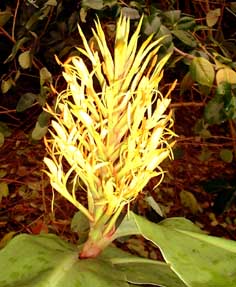 Hedychium
gardnerianum (Kahili ginger) from N. India and the Himalayas. Planted
in a rather shady place, this plant struggles into flower in mid to late
November. (Photographed November 27, 2000) Hedychium
gardnerianum (Kahili ginger) from N. India and the Himalayas. Planted
in a rather shady place, this plant struggles into flower in mid to late
November. (Photographed November 27, 2000) |
|
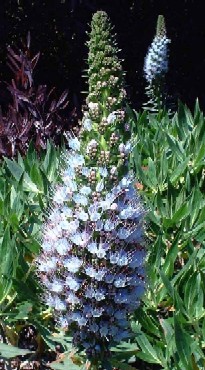 Echium candicans
(syn Echium fastuosum) Pride of Madeira. This
evergreen perennial has pikes of tiny purple-blue flowers that appear in
spring. At Earlscliffe, this plant has so far survived undamaged by - 4
degrees C during the 1999/2000 winter
Echium candicans
(syn Echium fastuosum) Pride of Madeira. This
evergreen perennial has pikes of tiny purple-blue flowers that appear in
spring. At Earlscliffe, this plant has so far survived undamaged by - 4
degrees C during the 1999/2000 winter |
|
Plant Collections
For more details of the plants that grow at Earlscliffe, see the following pages
Plants that grow well at Earlscliffe
4 year pictorial study of plants at Earlscliffe (2000 to 2003)

